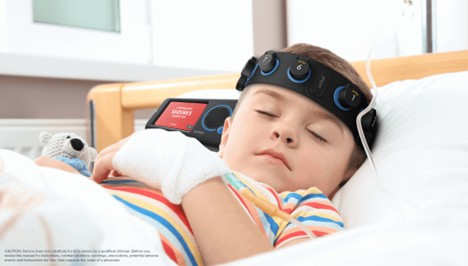Powered by Clarity, the Ceribell System will enable rapid, bedside detection, diagnosis and treatment of non-convulsive seizures in children experiencing neurological emergencies
SUNNYVALE, Calif., April 15, 2025 (GLOBE NEWSWIRE) -- CeriBell, Inc. (Nasdaq: CBLL) (“Ceribell”), a medical technology company focused on transforming the diagnosis and management of patients with serious neurological conditions, today announced that the U.S. Food and Drug Administration (FDA) has granted 510(k) clearance for its next generation Ceribell Clarity™ algorithm for the detection of electrographic seizures in patients ages 1 and older. This makes Ceribell the first and only AI-powered point-of-care EEG system cleared to detect electrographic seizures in children as young as 1 year old and to fully cover the age range from 1 year old to adult.1 Using Ceribell’s comprehensive solution, clinicians will be empowered to detect non-convulsive seizures in pediatric patients in real time, supporting rapid diagnosis and treatment to help prevent serious brain injury in one of the most common neurological emergencies that children face.2
Based on Ceribell’s assessment, its Clarity algorithm now provides coverage across the largest age range ever addressed by a seizure detection technology. This offers hospitals, particularly emergency departments and ICUs, a complete solution for detecting electrographic seizures in both pediatric and adult patients. The pediatric clearance was supported by electroencephalography (EEG) data collected from over 1,700 patients, which FDA data indicates is the largest validation dataset ever used for FDA clearance of a seizure detection system, reflecting the scale of Ceribell’s extensive EEG database and the rigor of its validation process and algorithm. The Clarity algorithm is designed to be used with the same Ceribell EEG headbands currently marketed for adults, which are cleared for use in patients of all ages.

FDA clearance of Ceribell’s Clarity™ algorithm will enable rapid, bedside detection, diagnosis, and treatment of non-convulsive seizures in children experiencing neurological emergencies.
“We believe this clearance will have a profound impact on the lives of critically ill children, who are particularly vulnerable to preventable brain injury,” said Jane Chao, Ph.D., co-founder and CEO of Ceribell. “It is well understood that seizures can lead to poor clinical outcomes when not treated in a timely manner. Yet, until now, clinicians have never had access to point-of-care EEG with a seizure detection algorithm tailored specifically for pediatric patients as young as 1 year old. This breakthrough, which we expect to be commercially available soon, marks another important step toward our mission of making rapid EEG the standard of care for everyone.”
Seizures are a leading cause of neurology-related pediatric emergency department visits.2 Non-convulsive seizure activity, which can only be detected with EEG, must be quickly identified and treated to prevent brain injury.3 Clinical guidelines recommend initiating EEG within 15–60 minutes of suspected continuous non-convulsive seizures in both children and adults.4 In practice, however, children often wait hours or even days for EEG assessment.5 Ceribell’s easy-to-use, AI-powered point-of-care EEG helps fill this critical gap by enabling prompt bedside neurological assessment and providing real-time insights into a patient’s condition.
References
- FDA 510k Clearance Letter K241589
- Pallin, D., et al (2008) Int J of Emer Med, 1(2), 97-105
- Payne, E.T., et al. (2014) Brain 137(5):1429-1438
- Brophy, G., et al. (2012) Neurocrit Care. 17(1):3-23
- Sánchez Fernández, I., et al. (2017) Epilepsia 58(3): 420–428
Forward-Looking Statements
This press release contains forward-looking statements within the meaning of the Private Securities Litigation Reform Act of 1995, including statements regarding our business plans, strategies, goals, prospects, assessments, beliefs and expectations for our products, and other statements that are not statements of historical fact. Given their forward-looking nature, these statements involve substantial risks, uncertainties, and potentially inaccurate assumptions, and we cannot ensure that any outcome expressed in these forward-looking statements will be realized in whole or in part. You can identify these statements by the fact that they use future dates or use words such as “will,” “may,” “could,” “likely,” “ongoing,” “anticipate,” “estimate,” “expect,” “project,” “intend,” “plan,” “believe,” “assume,” “target,” “forecast,” “guidance,” “goal,” “objective,” “aim,” “seek,” “potential,” “hope,” and other words and terms of similar meaning. Among the factors that could cause actual results to differ materially from past results and future plans and projected future results are the following: risks related to the macroeconomic and geopolitical environment and the potential imposition of new or higher tariffs; risks related to our limited operating history and history of net losses; our ability to successfully achieve substantial market acceptance and adoption of our products; competitive pressures; our ability to adapt our manufacturing and production capacities to evolving patterns of demand, governmental actions and customer trends; the manufacturing of a substantial number of our product components and their assembly in China; product defects or complaints and related liability; the complexity, timing, expense, and outcomes of clinical studies; our ability to obtain and maintain adequate coverage and reimbursement levels for our products; our ability to comply with changing laws and regulatory requirements and resulting costs; our dependence on a limited number of suppliers; and other risks and uncertainties, including those described under the heading “Risk Factors” in our Annual Report on Form 10-K and other reports filed with the U.S. Securities and Exchange Commission (“SEC”). These filings, when made, are available on the Investor Relations section of our website at https://investors.ceribell.com and on the SEC’s website at https://sec.gov. We assume no obligation to update any forward-looking statements contained in this press release as a result of new information or future events or developments.
About CeriBell, Inc.
Ceribell is a medical technology company focused on transforming the diagnosis and management of patients with serious neurological conditions. Ceribell has developed the Ceribell System, a novel, point-of-care electroencephalography (“EEG”) platform specifically designed to address the unmet needs of patients in the acute care setting. By combining proprietary, highly portable, and rapidly deployable hardware with sophisticated artificial intelligence (“AI”)-powered algorithms, the Ceribell System enables rapid diagnosis and continuous monitoring of patients with neurological conditions. The Ceribell System is FDA-cleared (510(k)) for indicating suspected seizure activity and currently utilized in intensive care units and emergency rooms across the U.S. Ceribell is headquartered in Sunnyvale, California. For more information, please visit www.ceribell.com or follow the company on LinkedIn.
Investor Contact
Brian Johnston or Laine Morgan
Gilmartin Group
Investors@ceribell.com
Media Contact
Corrie Rose
Press@ceribell.com
A photo accompanying this announcement is available at https://www.globenewswire.com/NewsRoom/AttachmentNg/a5d2bbd3-b571-45d2-8d7f-7ed4a6e1c71e





